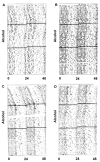Alcohol, antidepressants, and circadian rhythms. Human and animal models
- PMID: 11584551
- PMCID: PMC6707123
Alcohol, antidepressants, and circadian rhythms. Human and animal models
Abstract
Alcohol consumption (both acute and chronic) and alcohol withdrawal have a variety of chronobiological effects in humans and other animals. These effects are widespread, altering the circadian rhythms of numerous physiological, endocrine, and behavioral functions. Thus, some of alcohol's negative health consequences may be related to a disruption of normal physiological timing. Most studies of alcohol's chronobiological effects have been conducted under natural conditions in which environmental stimuli, such as regular cycles of light and darkness, act to coordinate circadian rhythms with the environment and with each other. However, such studies cannot distinguish between effects occurring directly on the circadian pacemaker and those occurring "downstream" from the pacemaker on the physiological control systems. Studies using animals have enabled researchers to begin to examine the effects of alcohol on circadian rhythms under so-called free-running conditions in experimental isolation from potential environmental synchronizers. These studies have provided preliminary evidence that alcohol's chronobiological effects are indeed the result of direct influences on the circadian pacemaker itself. Furthermore, the effects of alcohol on animal circadian rhythms appear similar to the effects seen during administration of antidepressant drugs. Taken together with evidence that the chronobiological effects of alcohol withdrawal in human alcoholics are reminiscent of those described in depressed patients, these observations suggest that alcohol may produce antidepressantlike effects on the circadian pacemaker. One theory suggests that the effects of alcohol on the circadian pacemaker are mediated in part by alterations in serotonin, an important chemical involved in cellular communication within the circadian system. However, other neurochemical systems also are likely to be involved.
Figures


Similar articles
-
Chronobiology of alcohol: studies in C57BL/6J and DBA/2J inbred mice.Physiol Behav. 2013 Feb 17;110-111:140-7. doi: 10.1016/j.physbeh.2013.01.001. Epub 2013 Jan 10. Physiol Behav. 2013. PMID: 23313401 Free PMC article.
-
Alcohol's interactions with circadian rhythms. A focus on body temperature.Alcohol Res Health. 2001;25(2):94-100. Alcohol Res Health. 2001. PMID: 11584555 Free PMC article. Review.
-
Effects of ethanol intake and ethanol withdrawal on free-running circadian activity rhythms in rats.Physiol Behav. 2005 Mar 31;84(4):537-42. doi: 10.1016/j.physbeh.2005.01.016. Physiol Behav. 2005. PMID: 15811388
-
Chronic ethanol intake alters circadian period-responses to brief light pulses in rats.Chronobiol Int. 2005;22(2):227-36. doi: 10.1081/cbi-200053496. Chronobiol Int. 2005. PMID: 16021840
-
[Aspects of chronobiological effects of ethanol].Psychiatr Pol. 2003 May-Jun;37(3):503-10. Psychiatr Pol. 2003. PMID: 13677979 Review. Polish.
Cited by
-
Effect of Prenatal Glucocorticoid Exposure on Circadian Rhythm Gene Expression in the Brains of Adult Rat Offspring.Cells. 2022 May 11;11(10):1613. doi: 10.3390/cells11101613. Cells. 2022. PMID: 35626652 Free PMC article.
-
Chronobiology of alcohol: studies in C57BL/6J and DBA/2J inbred mice.Physiol Behav. 2013 Feb 17;110-111:140-7. doi: 10.1016/j.physbeh.2013.01.001. Epub 2013 Jan 10. Physiol Behav. 2013. PMID: 23313401 Free PMC article.
-
CLOCK is suggested to associate with comorbid alcohol use and depressive disorders.J Circadian Rhythms. 2010 Jan 21;8:1. doi: 10.1186/1740-3391-8-1. J Circadian Rhythms. 2010. PMID: 20180986 Free PMC article.
-
Alcohol consumption and the use of antidepressants.CMAJ. 2007 Feb 27;176(5):633-7. doi: 10.1503/cmaj.060446. CMAJ. 2007. PMID: 17325328 Free PMC article.
-
Circadian activity rhythms and voluntary ethanol intake in male and female ethanol-preferring rats: effects of long-term ethanol access.Alcohol. 2014 Nov;48(7):647-55. doi: 10.1016/j.alcohol.2014.07.010. Epub 2014 Sep 16. Alcohol. 2014. PMID: 25281289 Free PMC article.
References
-
- Baird TJ, Briscoe RJ, Vallett M, et al. Phase-response curve for ethanol: Alterations in circadian rhythms of temperature and activity in rats. Pharmacology Biochemistry and Behavior. 1998;61:303–315. - PubMed
-
- Barr SI. Influence of increasing concentrations of ethanol on food and water intake, body weight, and wheel running of male Sprague-Dawley rats. Pharmacology Biochemistry and Behavior. 1988;29:667–673. - PubMed
-
- Buijs RM, Kalsbeek A, Romijn HJ, Pennartz CMA, Mirmiran M, editors. Hypothalamic Integration of Circadian Rhythms. Amsterdam: Elsevier; 1996.
-
- Bunning E. The Physiological Clock: Circadian Rhythms and Biological Chronometry. New York: Springer; 1973.
Publication types
MeSH terms
Substances
LinkOut - more resources
Full Text Sources
Medical
